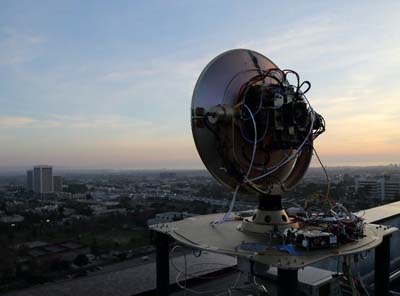Northrop Grumman Corp. (NGC) and DARPA set a new standard for wireless transmission by operating a data link at 100 Gbps over a distance of 20 km in a city environment (Los Angeles).
The 100G system is capable of rate adaptation on a frame by frame basis, from 9 to 102 Gbps, to maximize the data rate throughout dynamic channel variations. Extensive link characterization demonstrated short-term error-free performance from 9 to 91 Gbps and a maximum data rate of 102 Gbps with 1 erroneous bit received for every ten thousand bits transmitted.
The data link performance results reflect the integration of several key technologies: The link operates at E-Band, 71 to 76 and 81 to 86 GHz, with 5 GHz of channel bandwidth, or data carrying capacity, and uses a bandwidth-efficient signal modulation to transmit 25 Gbps data streams on each 5 GHz channel. To double the rate within the fixed bandwidth, the data link transmits dual orthogonally polarized signals from each antenna. Additionally, the link uses spatial multiplexing, transmitting from two antennas simultaneously, with MIMO signal processing to separate the signals at the two receiving antennas — again doubling the data rate within the fixed bandwidth.
Northrop Grumman’s 100G team includes Raytheon, responsible for developing the millimeter wave antennas and related RF electronics, and Silvus Technologies, providing the spatial multiplexing and MIMO signal processing technologies.
The two-way data link, which featured active pointing and tracking, was demonstrated January 19, 2018 in Los Angeles. The demonstration marked the successful completion of Northrop Grumman’s Phase 2 contract for DARPA’s 100 Gbps (100G) RF Backbone program.
Next Phase
The successful 100G ground demonstration set the stage for the flight test phase of the 100G RF Backbone program. This phase, which started in June, will demonstrate the 100G air-to-ground link up to 100 Gbps over a 100 km range and extended ranges with lower data rates.
A 100G data link can transmit high-rate data directly from the aircraft to commanders on the ground in near real-time, allowing them to respond more quickly to dynamic operations.
The 100G hardware will be flown aboard the Proteus demonstration aircraft developed by Northrop Grumman subsidiary Scaled Composites.
According to Louis Christen, director, research and technology at Northrop Grumman, “This dramatic improvement in data transmission performance could significantly increase the volume of airborne sensor data that can be gathered and reduce the time needed to exploit sensor data. Next generation sensors such as hyperspectral imagers typically collect data faster and in larger quantity than most air-to-ground data links can comfortably transmit. Without such a high data rate link, data would need to be reviewed and analyzed after the aircraft lands.”

